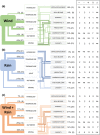Storm impacts on phytoplankton community dynamics in lakes
- PMID: 32133744
- PMCID: PMC7216882
- DOI: 10.1111/gcb.15033
Storm impacts on phytoplankton community dynamics in lakes
Abstract
In many regions across the globe, extreme weather events such as storms have increased in frequency, intensity, and duration due to climate change. Ecological theory predicts that such extreme events should have large impacts on ecosystem structure and function. High winds and precipitation associated with storms can affect lakes via short-term runoff events from watersheds and physical mixing of the water column. In addition, lakes connected to rivers and streams will also experience flushing due to high flow rates. Although we have a well-developed understanding of how wind and precipitation events can alter lake physical processes and some aspects of biogeochemical cycling, our mechanistic understanding of the emergent responses of phytoplankton communities is poor. Here we provide a comprehensive synthesis that identifies how storms interact with lake and watershed attributes and their antecedent conditions to generate changes in lake physical and chemical environments. Such changes can restructure phytoplankton communities and their dynamics, as well as result in altered ecological function (e.g., carbon, nutrient and energy cycling) in the short- and long-term. We summarize the current understanding of storm-induced phytoplankton dynamics, identify knowledge gaps with a systematic review of the literature, and suggest future research directions across a gradient of lake types and environmental conditions.
Keywords: climate change; environmental disturbance; extreme events; functional traits; mixing; nutrients; stability; watershed.
© 2020 The Authors. Global Change Biology published by John Wiley & Sons Ltd.
Figures





References
-
- Abbott, M. R. , Denman, K. L. , Powell, T. M. , Richerson, P. J. , Richards, R. C. , & Goldman, C. R. (1984). Mixing and the dynamics of the deep chlorophyll maximum in Lake Tahoe. Limnology and Oceanography, 29, 862–878. 10.4319/lo.1984.29.4.0862 - DOI
-
- Abonyi, A. , Leitão, M. , Stanković, I. , Borics, G. , Várbíró, G. , & Padisák, J. (2014). A large river (River Loire, France) survey to compare phytoplankton functional approaches: Do they display river zones in similar ways? Ecological Indicators, 46, 11–22. 10.1016/j.ecolind.2014.05.038 - DOI
-
- Aguilera, R. , Livingstone, D. M. , Marcé, R. , Jennings, E. , Piera, J. , & Adrian, R. (2016). Using dynamic factor analysis to show how sampling resolution and data gaps affect the recognition of patterns in limnological time series. Inland Waters, 6, 284–294. 10.1080/IW-6.3.948 - DOI
Publication types
MeSH terms
Grants and funding
- G17AC00044/U.S. Geological Survey/International
- NE/J024279/1/Natural Environment Research Council/International
- Fondation pour la Recherche sur la Biodiversite/International
- G16AP00087/Vermont Water Resources and Lake Studies Center/International
- OIA-1556770/U.S. National Science Foundation/International
- EF-1702506/U.S. National Science Foundation/International
- CNS-1737424/U.S. National Science Foundation/International
- ICER-1517823/U.S. National Science Foundation/International
- DEB-1753639/U.S. National Science Foundation/International
- H2020-MSCA-ITN-2016/MANTEL/International
- PBA/FS/16/02/Irish Government/International
- 791812/European Union/International
- U.S. Department of State/International
- Centre Alpin de Recherche sur les Réseaux Trophiques des Ecosystèmes Limniques/International
- 2017-06421/Swedish Research Council/International
LinkOut - more resources
Full Text Sources

